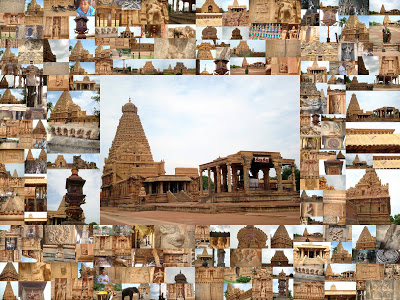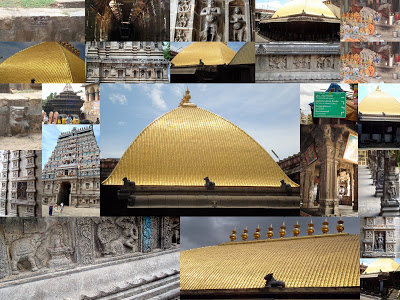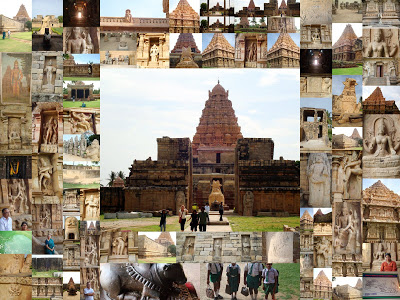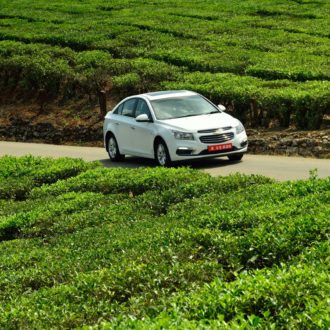The Chola Trail – roads taken in 2008
The Chola trail gave me something more than just an dose of history. A sense of identity as well. It is very difficult to be objective and write about the trail , so I am not even trying as of now. I am just putting down some raw information to help you understand the might and the glory of this dynasty, which was one of the most powerful in South India and they established its supremacy in South Asia as well.
This ancient Tamil dynasty held sway for more than 1500 years and its origins are mired in myths and poetry as the chronology matches the reign of Emperor Ashoka (273 BC-232 BC). Literature heralds the rulers to be descendants of the Sun God.Historically though the reign is divided into three distinct eras –the early Cholas (2nd century BC-9th century AD), the medieval Cholas (9th -11th century AD) and the later Cholas (11th -13th century AD).Our story starts somewhere in the middle of 10th century and moves on to the 12th during the reign of Raja Raja Chola 1 and his son Rajendra Chola 1 and later on to Raja Raja Chola II
Darasuram
All that remains today as a witness to their might are The Great Living Chola temples . The Brihadeshwar temples in Thanjavur and Gangaikondacholapuram and the Airaveteshwar temple at Darasuram built by these kings are part of UNESCO World heritage Site and this is where the trail actually begins .
The Big Brihadeshwara Temple, Thanjavur
We start with Thanjavur, the original BIG Brihadeshwara temple , or the Periya Koil built by Raja Raja Chola 1 in the 11th century in Thanjavur.This was the moment I was waiting for, a moment that defined this trail for me.My eyes follow the Vimana of the temple as my neck crane to capture its height. It is an understatement to call it big. It is larger than life .Consider this . At a height of 216 feet the towering Vimana is the tallest of its kind in the world dwarfing the Gopura, or the outer tower. The shikara or the golden dome replete with numerous stucco figures weighs 80 tonnes . Elephants were apparently used to draw this single granite block on a 6 km ramp to place it on top. The Nandi weighs 27 tonnes and is the second largest in the country while the main deity, the Shivalinga is at a height of 8.7 metres, the largest in the world. Life size representations of Gods and Goddesses fill the sculptured panels and the temple is a repository of records for posterity . 108 Bharatnatyam dance postures are depicted here and the corridors and ceilings are a colourful blend of fresco and mural paintings –unique to this dynasty.Architecturally the temple is the most ambitious structural granite temple to be ever built in the world and hence it is the first to become a Great Living Chola temple and part of the UNESCO World Heritage Site .There is so much to say, but I will end here for now about this temple.
I went to the 11th century when Rajendra Chola 1 , the next ruler had moved beyond South India and invaded East upto the Gangetic Plain and created ripples overseas in Asia and overpowered all of today’s Srilanka, Maldives, Malaysia and Indonesia. Yet, his capital ,Gangaikondacholapuram that controlled this mighty empire for over 250 years has simply vanished from the face of this earth. When Rajendra Chola 1 conquered the Gangetic plain, he wanted to celebrate . He also wanted to portray to posterity that he was probably greater than his father Raja Raja Chola 1 who had immortalised himself with the Big Brihadeshwara temple in Thanjavur. So Rajendra took a step further. After all, he was the commander in chief in his father’s army as well. He moved away from Thanjavur , his father’s capital and built another Brihadeshwara temple in a new found capital called Gangaikondacholapuram which literally means the town of the Chola who captured even the Ganges. However he did not complete the temple. And he finally ensured that his father’s temple was bigger than his . Its tempting to delve deeper and share stories and information about the temple, but I wouldnt know where to end …
The third destination was Darasuram at the Airavateshwar temple built by Raja Raja Chola II in the 12th century . Called Rajarajapuram , this is indeed a sculpture’s dream in stone. A temple shaped like a chariot drawn by horses and supported by 100 monolith pillars carved exquisitely greet us. And finally ,a Chola trail is incomplete if one does not refer to the golden Chidambaram temple . 
Chidambaram
Do enjoy the pictures for now..I may at a later stage write in detail about these temples. However if you are eager to read more, my friend’s Vijay’s site , Poetry in stone will give you information on the temples. Vijay himself is a treasure house of knowledge when it comes to the sculptures and he along with Siva helped me a lot during this trail. My uncle and my mother who accompanied me shared a lot of their knowledge with me as well.



Wow, very elaborate and very well written. Nice collage too.
Hi Lakshmi,
Your collages are making me feel jealous. Its a refreshingly different way of presenting the amazing sculptures.
I would have like to list them as Chidambaram, Tanjore, GKC and Darasuram and maybe tirubuvanam as well. Chidambaram is first among temples for cholas and they were crowned there ( even after the big temple was built and consecrated they followed this tradition)
There are a lot of interesting riddles, legends, myths associated with these.
Simple ones the shadow not falling etc have already been proved to be wrong.
The 6km ramp – has been challenged by recent postulates – who have come up with a circular ramp around the vimana itself.
The top shikaara was thought to be made of a single stone weighing 80 tonnes – but recent experts ( during the kumbabishkam) found it was actually 8 pieces of stone – arranged like the slices of an orange fruit.
The Gold khalasa – pot on top – is very imporant – as the date of Raja Raja donating Gold for it from inscriptions is the only reference we have to the possible completion date of the big temple – On the 275th day of the 25th year the king – ie 985AD + 25 = 1010 AD.
The most striking puzzle is why is the big temple consecrated unfinished – only 81 of the 108 dance karanas were completed. Post Raja Raja demise in 1014 AD – ( his last inscriptions are from 29th year of reign) – till 1025 AD, Rajendra ruled from Chidambaram.
Apologise for the long comment, but the subject is dear to my heart and hence…
rgds
vj
A very nice recollection and Collage. I am sure you have many interesting memories of this years, to look back at.
That was a great write-up. It brings out your passion for these almost-forgotten historic temples.
I love the collages
I haven’t been to any of those temples..been to Kumbakonam,but missed Tanjavur…
Hi,
I think you and me share the same passion, i.e. traveling, and giving words to our travel experiences.
Regards
Amjad
I’m lovin’ the collages. Very arty.
Hi Lakshmi! Hope you had a great holiday season and wish you a 2009 much better than we can anticipate and at least as better as if your dreams come true! Health, Peace, and… some money to spend… 😉 And lots of travelling… ;))
Gorgeous posts!
As for Blogtrotter, it’s visiting the Red Fort in Delhi. Hope you enjoy and have a great week!
PS: Your template looks magnificent on my new monitor; which one is it?
A nice post, I guess that is a wonderful way of holding on to the things you love, the things you are, the things you never want to lose. It’s only the memory, where we live more often with our dreams 🙂
– Happy blogging
that was a very interesting post…
loved it and ignited the urge to visit these temples soonest!
Loved these collages too (in addition to those in the newer post)
Superb!!! Brilliant 🙂
Fully enjoyed the Chola Trail. I appreciate your ability in containing yourself and resisting the temptation to detail out everything possible.
Arun – Thanks ..Its interesting to present a trip in collages, i guess
Vijay – Thanks for the patience in writing such a long comment..as always, your comments are enriching, not just to me but to my readers as well 🙂
Ajeya – Thats the best part of travelling ..
Vamsee – Thanks..Im quite obsessed with these trails and not many I know share an enthusiasm for it 🙂
Vishesh – Im sure you will and you will feel poetic abt the sculptures
Anjad -Thanks for dropping in ..I will check your space soon
Wendy -Thanks..I thought it adds a different perspective 🙂
Gil – Thanks..I do wish the money part comes in soon so that I can start travelling again 🙂 wish you a wonderful year as well
Alok – A poetic comment..very true…memories are all that we are made of..
Deepak – Any time 🙂
Priyank – Thanks..They justify taking all the pics I guess 🙂
Praveen -Thanks 🙂
PNS – It was a tough call actually..thanks
can you email me: [email protected], i have some question wanna ask you.thanks
Very interesting pictures…liked all the collages…the speak more than 1000 words…
thanks…
Just happened to clickin to your blog..
Hats Off!!
Wonderful collection with lovely pics…
Was taken around to places…
Keep rocking!
They are in the same city, Yiwu. They are from United states, Canada and United Kingdom. They are sourcing small commodities in Yiwu wholesale market.
hi .. ur blog s really good… and they say tat raja raja’s pallipadai i mean his samadhi is somewhere nearby dharasuram… do u knw the correct location .. if so pls do a mail……..
You are indeed a great traveler and writer. These days m writing about my oxford and London trip. have a look at http://www.itravelilive.com
I am at awe after reading this account. The rich history of the Cholas and the Pandyas are very interesting subjects to study and explore. I am further enlightened by your article about various facts and myths about these architectural wonders. It would only be natural that I should soon hit the road to Thanjavur, which also happens to be my forgotten ancestral land.
Thanks so much..I did a very brief trip and I am hoping to go there again and delve more. Hope you visityour town soon.
Regards
lakshmi